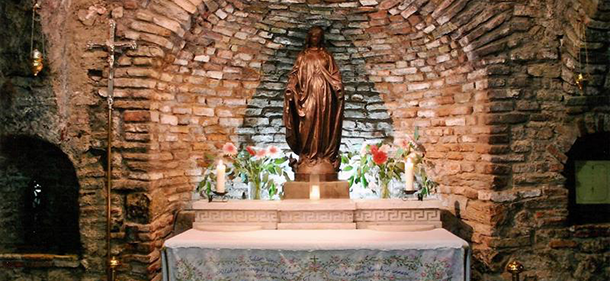Seven Churches in Biblical Anatolia
This is an exciting tour featuring visiting to the cities associated with the Seven Churches in Revelation 1: Ephesus, Smyrna, Pergamum, Thyatira, Sardis, Philadelphia, and Laodicea. In addition to visiting these ancient cities, you will also enjoy sightseeing in Istanbul. Nicaea, Miletus. Colossae, Hierapolis, and Bursa. You will even visit the thermal springs of Pamukkale, a spectacular site of thermal waters.
Day 1: Arrive Istanbul
Upon arrival at the airport you will be met by Esendal Travel representative who will assist you with customs and transfer you to your hotel for lunch. After lunch we will visit the Blue Mosque, famous for its six minarets and interior blue tiles. We will also visit Byzantine Hippodrome where chariot races were once held, and the Topkapi Palace, once the residence of the Ottoman Sultans between the 15th and 19th centuries. Dinner and overnight in Istanbul will be at our hotel in Istanbul (L, D).
Day 3: Istanbul
Our first stop today will be the Chora Church with its amazing frescos, mosaics, and funerary chapel (Paracclesion). Then we will visit the Basilica of St. Sophia. Which has inspired architects and religious leaders for over fifteen hundred years. The 1st one Constructed in 326 by Constantine the Great, the last Hagia Sophia was built in 532 by Justinian as basilica which has been a cathedral, a mosque, and now a museum. Our tour also includes a visit to the Grand Bazaar with its 4.000 tiny shops. During our tour of the Grand Bazaar you will see very colorful shops and different items ; Grand Bazaar is the oldest and largest mall in the world like a labyrinth and very famous for its souvenirs shops. if time permits we will also visit the colorful Spice Bazaar where several herbs and spices are still being sold.. Dinner and overnight will be at our hotel in Istanbul. (B, L, D)
Day 4: Istanbul , Gallipoli Peninsula, Anzac Cemetery, Troy, Alexandria Troas, Assos/ Ayvalik
Today we have an early departure as we check out of our hotel in Istanbul and travel to Troy. On the way we will drive on the European shore of the Sea Marmara heading west to the Dardanelles. There we will visit the World War I battlefields on the Gallipoli peninsula and pay tribute to the all heroes lost their lives on Gallipoli. Under the terms of the Armistice with Turkey at the end of the World War I, the Allies returned to the Gallipoli Peninsula and cleared the battlefields of the bodies still unburied. In the nine months of the campaign more than a half million casualties. The British Empire suffered over 200,000 casualties with the loss of some 36.000 lives. Half the 500,000 Ottoman troops became casualties, with more than 55000 dead. Commonwealth solders died there. Australia suffered 26.094 casualties there, by far the most casualties of the Commonwealth armies.
The 31 war cemeteries on the peninsula contain 22.000 graves, but only 9000 of the bodies were able to be identified. Afterwards we will cross the Dardanelles by ferry to the Troy area where you will set foot on Asian soil. Here we will visit Troy, the ideal place to brush up on Homer`s Trojan War, hollow horse and all. We will then travel to Alexandria Troas, the city where Paul received the Macedonian Call (Acts 16:7-10) and raised Eutychus from the dead (Acts 20:10). We will continue south to Assos. We know from Acts 20:13-14 that Paul visited Assos after he left Alexandria Troas. Dinner and overnight will be at our hotel in Assos or Ayvalik (B, L, D)
Day 5: Assos /Ayvalik – Pergamos – Smyrna – Izmir
After breakfast we will leave Assos / Ayvalik and drive south to Pergamum, one of the Seven Churches of Asia Minor (Revelation 2:12-17). Today Pergamum is known as Bergama. Ancient Pergamum was the city that invented parchment and was a commercial rival to Ephesus and was a center of art and science. Here we will explore the Alter of Zeus, the Temple of Athena, the steepest theater, the Trajan Temple, the worldwide known Pergamum Library on the Pergamum Acropolis founded on the hilltop. Pergamum Acropolis which was built for social and cultural activities and was the capital city of rich Pergamum Kingdom. The ancient Pergamum also contains the remains of Asklepion, the famous medical center where Galen (131-210 AD) laid down the fundamentals of medical practice that would last for more than a millennium. After lunch we will travel to Izmir visit the Church of St.Policarp, the oldest church in ancient Smyrna and symbolized the communities of the Seven Churches of Revelation. We will then check in to hotel in Izmir for dinner and overnight (B, L, D)
Day 6: Izmir – Ephesus – Kusadasi
We will leave Izmir this morning and drive to Ephesus (Revelation 2:1-7). It was here that Paul stayed and taught for two years (Acts 19:10), and where he promised on his second journey, “I will return to you again if God wills…” (Acts 18:21, NASB). Our first stop on today`s tour will be at the House of Virgin Mary where, according to tradition, Mary spent the last years of her life. We will then visit the Basilica of St. John, built in the sixth century. It is believed that John the apostle is burned here. Just below the church are the remains of the Temple of Artemis, one of the seven wonders of the ancient world. We then drive a short distance to the ancient city of Ephesus, one of the most complete cities ever excavated. History truly comes to life in these ancient ruins. You will walk towards the ancient harbor, down a marble road rutted by the wheels of countless chariots, and pass such architectural masterpieces as the Magnesian Gate, gymnasiums, bath houses, public latrines, and the Library of Celsius, before arriving at the Great Amphitheater. Here we will stand in the very large theater where Paul confronted the followers of the goddess Diana (Acts 19:24ff). After our tour of Ephesus we will drive a short distance to the port city of Kusadasi where the balance of the day is at leisure. Dinner and overnight will be at our hotel in Kusadasi (B, L, D)
Day 7: Kusadasi – Miletus- Laodicea – Pamukkale
This morning we motor along the old caravan route connecting the Aegean port to the Silk Road. Our first will be at the port city of Miletus. Paul visited Miletus at the end of his third missionary journey. It was here that Paul spoke to the eldest from the church at Ephesus about his inner compulsion to go to Jerusalem, and he predicted his future imprisonment (Acts 20). We then drive though the Menderes River Valley, to Colossae, famous as the receiver of Paul`s Letter to the Colossians. In modern times the town of Colossae has fallen in to obscurity but we will see a few remains of the Theater, the Necropolis and the Church. We continue our tour with a visit to Laodicea. Jesus rebuked this church for being lukewarm (Revelation 3:14-22). Comprehensive excavations have not yet been done at Laodicea, but we will see some remains of a stadium, a water tower, a gymnasium and baths complex, an Odeon, a Nympheum, a large Hellenistic theater, a small Roman theater, and some fragmentary remnants of the defense walls. After lunch we will stop at the ruins of the ancient city of Hierapolis. Paul commended Epaphras for the zeal he had for the Christians at Hierapolis (Colossians 4:13). At Hierapolis we will visit the city walls, the octagonal Martyrium of St. Philip, the 2nd century Theater, Temple of Apollo, a basilica, and the necropolis. The necropolis covers an area of more than one mile and contains some of the best examples of tomb style. It is one of the best preserved ancient cemeteries in all of Anatolia. After our tour of Hierapolis we will travel to Pamukkale, truly a spectacular natural site, unique in the entire world. Pamukkale is a fairyland of dazzling white, petrified castles. Thermal spring waters laden with calcareous salts running off the plateau`s edge have created this fantastic formation of stalactites, cataracts and basins. The hot springs have been used since Roman times for their therapeutic powers. Both the thermal center with its motels and thermal pools are situated on the plateau. A leisurely bath in a pool of hot thermal water will be the perfect way to relax after dinner. (B, L. D)
Day 8: Pamukkale – Philadelphia – Sardis – Thyatira – Bursa
We leave Pamukkale this morning and drive to Bursa. Be sure to enjoy the ever changing landscapes and timeless scenes of rural life that you will see along the way. The first stop on our tour today is Philadelphia, referred to as the New Jerusalem (Revelation 3:7-13). It was the least important cities of the ones mentioned in the book revelation. Today Philadelphia is known as Alasehir. We will see portions of an early church, the city wall, and we will visit the Byzantine Basilica. The next stop is made in Sardis. Jesus rebuked the church at Sardis for its facade of strength when, in reality, it was weak (Revelation 3:1-6). At Sardis we will explore the massive scale of the Temple of Artemis of Artemis and the white marble royal road, the gymnasium and the synagogue. After lunch we will travel to Thyatira (Revelation 2:18-29). The Thyatira was a commercial center in west central Asia Minor. It was located in a fertile valley though which trade routes passed. Textiles were among Thyatira’s most important products. One of the town`s cloth merchants was a woman named Lydia, who was converted and baptized (Acts 16:14-15). Afterwards we will travel to Bursa to visit the ornate Green Ottoman Complex, where the first Sultan Mehmet I is burned. We will also visit the Great Mosque, composed of a large central hall measuring sixty-three meters by fifty meters. The mosque is covered with twenty domes supported on round arches that fall on thirty piers arranged in a regular grid. We will also visit the ancient covered bazaar and silk market. Dinner and overnight will be at our hotel in Bursa. (B, L, D)
Day 9: Bursa – Nicaea – Istanbul
After breakfast we will drive back to Istanbul. On the way we will visit ancient Nicaea, one of the most important cities of Bithynia during the time of Paul`s travels. Nicaea was also the home of the First Ecumenical Council of 325 AD and the Seventy Ecumenical Council of 787 AD. Nicaea was also the place where the principle of church state cooperation was first admitted. Upon arrival in Istanbul we will visit the Beylerbeyi Palace. Time and weather permitting we will take a cruise on the Bosporus River. The Bosporus River separates Asia from Europe. While on the cruise we will view great landmarks such as the Dolmabahce Palace, Ortakoy mosque, and the Rumeli Hisar Fortress, the beautiful 19th and 20th centuries Ottoman Mansions along the shore of Bosporus .Tonight we will enjoy a farewell dinner at our hotel (B, L, D)
Day 10: Istanbul – USA
After breakfast Esendal Travel guide or representative will transfer you to Istanbul Airport for your return flight home. In flight you can fellowship with your friends and remember the things you shared together. (B)


